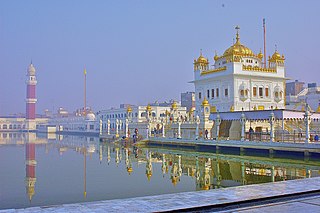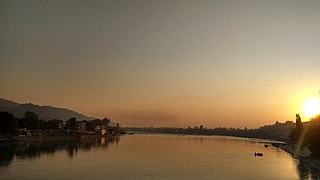
Guru Har Rai revered as the seventh Nanak, was the seventh of ten Gurus of the Sikh religion. He became the Sikh leader at age 14, on 3 March 1644, after the death of his grandfather and the sixth Sikh leader Guru Hargobind. He guided the Sikhs for about seventeen years, till his death at age 31.

Guru Har Krishan also known as Bal Guru, or Hari Krishan Sahib, was the eighth of the ten Sikh Gurus. At the age of five, he succeeded his father, Guru Har Rai, and became the youngest Guru in Sikhism. He contracted smallpox in 1664 and died before reaching his eighth birthday. It is said that he died because he contracted smallpox while successfully curing his followers.

Guru Tegh Bahadur was the ninth of ten gurus who founded the Sikh religion and was the leader of Sikhs from 1665 until his beheading in 1675. He was born in Amritsar, Punjab, India in 1621 and was the youngest son of Guru Hargobind, the sixth Sikh guru. Considered a principled and fearless warrior, he was a learned spiritual scholar and a poet whose 115 hymns are included in the Guru Granth Sahib, which is the main text of Sikhism.

Dehradun, also known as Dehra Doon, is the winter capital and the most populous city of the Indian state of Uttarakhand. It is the administrative headquarters of the eponymous district and is governed by the Dehradun Municipal Corporation, with the Uttarakhand Legislative Assembly holding its winter sessions in the city as its winter capital. Part of the Garhwal region, and housing the headquarters of its Divisional Commissioner, Dehradun is one of the "Counter Magnets" of the National Capital Region (NCR) being developed as an alternative centre of growth to help ease the migration and population explosion in the Delhi metropolitan area and to establish a smart city in the Himalayas.

Tarn Taran Sahib is a city in the Majha region of the state of Punjab, in northern India. It is the district headquarters and hosts the municipal council of Tarn Taran district. Gurdwara Sri Tarn Taran Sahib, a prominent Sikh shrine, is located in the central part of the city.

Udasis, also spelt as Udasins, also known as Nanak Putras, are a religious sect of ascetic sadhus centred in northern India who follow a tradition known as Udasipanth. Becoming custodians of Sikh shrines in the 18th century, they were notable interpreters and spreaders of the Sikh philosophy during that time. However, their religious practices border on a syncretism of Sikhism and Hinduism, and they did not conform to the Khalsa standards as ordained by Guru Gobind Singh. When the Lahore Singh Sabha reformers, dominated by Tat Khalsa Sikhs, would hold them responsible for indulging in ritual practices antithetical to Sikhism, as well as personal vices and corruption, the Udasi mahants were expelled from the Sikh shrines.
Jainism (/ˈdʒeɪnɪzəm/), traditionally known as Jain Dharma, is an ancient Indian religion. Jain dharma traces its spiritual ideas and history through a succession of twenty-four leaders or tirthankaras, with the first in current time cycle being Lord Rishabhanatha, whom the Jain tradition holds to have lived millions of years ago, the twenty-third tirthankara Parshvanatha whom historians date to 8th or 7th century BCE, and the 24th tirthankara, Mahāvīra around 500 BCE. Jains believe that Jainism is an eternal dharma with the tirthankaras guiding every cycle of the Jain cosmology.

Anandpur Sahib, also referred simply as Anandpur, is a city in Rupnagar district (Ropar), on the edge of Shivalik Hills, in the Indian state of Punjab. Located near the Sutlej River, the city is one of the most sacred religious places in Sikhism, being the place where the last two Sikh Gurus, Guru Tegh Bahadur and Guru Gobind Singh, lived. It is also the place where Guru Gobind Singh founded the Khalsa Panth in 1699. The city is home to Takhat Sri Kesgarh Sahib, the third of the five Takhts in Sikhism.

Dehradun district is a district in Garhwal which is a part of Uttarakhand state in northern India. The district headquarters is Dehradun, which has also served as the interim capital of Uttarakhand since its founding in 2000. The district has 6 tehsils, 6 community development blocks, 17 towns and 764 inhabited villages, and 18 unpopulated villages. As of 2011, it is the second most populous district of Uttarakhand, after Haridwar. Dehradun district also includes the prominent towns of Rishikesh, Mussoorie, Landour and Chakrata. The district stretches from the Ganges river in the east to the Yamuna river in the west, and from the Terai and Shivaliks in the south and southeast to the Great Himalaya in the northwest. During the days of British Raj, the official name of the district was Dehra Dun. In 1842, Dun was attached to Saharanpur district and placed under an officer subordinate to the Collector of the district but since 1871 it is being administered as separate district.

Goindwal, also known as Goindwal Sahib and alternatively transliterated as Goindval, is located in the Taran Taran district of the Majha region of Punjab, India about 23 km (14 mi) from Tarn Taran Sahib. In the 16th century it became an important center for the Sikh religion during the Guruship of the Guru Amar Das Ji. Goindwal is on the banks of the Beas River and is one of the focal points of small scale industries of Tarn Taran district.

Bhai Mani Singh was an 18th-century Sikh scholar and martyr. He was a childhood companion of Guru Gobind Singh and took the vows of Sikhism when the Guru inaugurated the Khalsa in March 1699. Soon after that, the Guru sent him to Amritsar to take charge of Harmandir Sahib, which had been without a custodian since 1696. He took control and steered the course of Sikh destiny at a critical stage in Sikh history. He was also a teacher of the Gianian Bunga, later becoming known as the "Amritsari Taksal", currently located in Sato Ki Gali.

Doiwala is a town and a Nagar Palika in Dehradun district in the state of Uttarakhand, India.

Sikh architecture is a style of architecture that was developed under the Sikh Confederacy and Sikh Empire during the 18th and 19th centuries in the Punjab region. Due to its progressive style, it is constantly evolving into many newly developing branches with new contemporary styles. Although Sikh architecture was initially developed within Sikhism its style has been used in many non-religious buildings due to its beauty. 300 years ago, Sikh architecture was distinguished for its many curves and straight lines; Keshgarh Sahib and the Harmandir Sahib are prime examples.

German Sikhs are a growing religious minority in Germany. The majority of German Sikhs have their roots from the Punjab, India with the remaining coming from the Afghan Sikh community or through conversion. The number of Sikhs is estimated to be between 25,000. Germany had the fifth highest Sikh population in Europe after United Kingdom (524,000), Italy (220,000), Portugal (35,000) and Spain (26,000).

Dehradun is the temporary capital of The Indian state of Uttarakhand, and has a rich and eventful history, it also finds mention in scriptures as well.

Ramraiyas, also referred to as Ram Raiyas, are a Sikh sect that follow Ram Rai, the excommunicated eldest son of Guru Har Rai (1630–61).
Shri Guru Ram Rai Institute of Medical & Health Sciences is a private medical college located in Patelnagar in Dehradun district, Uttarakhand, India. The medical college hospital was started in April 2002 and the college received permission for MBBS admission in 2006 and Postgraduate courses started in 2011. It was affiliated to Hemwati Nandan Bahuguna Uttarakhand Medical Education University. It has an annual intake of 150 for MBBS seats and 97 Post graduate seats in various specialties recognized by MCI. In 2017 it became a constituent college of Shri Guru Ram Rai University.

Ram Rai was the excommunicated eldest son of the seventh Sikh Guru, Guru Har Rai, and the founder of the Ramraiyas, an unorthodox and heretical sect in Sikhism.

Brahmin Sikh is a Sikh religious group whose members belong to Brahmin community. They played a key role in the early years of Sikhism. Sometimes they are called Kashmiri Sikhs, for those who are of Kashmiri origin.




















